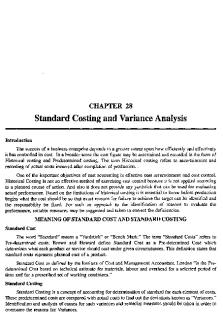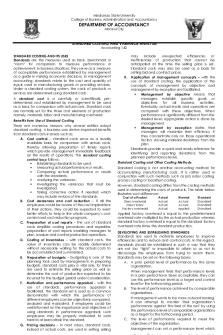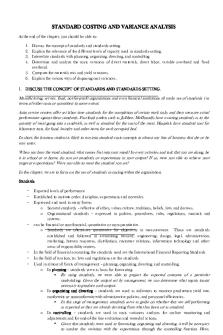Standard Costing - Copy PDF

| Title | Standard Costing - Copy |
|---|---|
| Course | Advanced Accounting |
| Institution | Ateneo de Manila University |
| Pages | 16 |
| File Size | 652.2 KB |
| File Type | |
| Total Downloads | 93 |
| Total Views | 704 |
Summary
Download Standard Costing - Copy PDF
Description
Standard Costing: A Functional-Based Control Approach Price and Quantity Standards and unit standard Cost •
Price standards: Specify how much should be paid for the quantity of the input to be used
•
Quantity standards: Specify how much of the input should be used per unit of output
•
Unit standard cost: Product of standard price (SP) and standard quantity (SQ)
Standards •
•
Sources of quantitative standards –
Historical experience
–
Engineering studies
–
Input from operating personnel
Price standards are the joint responsibility of operations, purchasing, personnel, and accounting –
Choices are limited by market forces, trade unions, and other external forces
Classification of Standards •
•
Ideal standards –
Demand maximum efficiency
–
Achieved only if everything operates perfectly
Currently attainable standards –
Can be achieved under efficient operating conditions
–
Allowance is made for normal breakdowns, interruptions, and less than perfect skill
Kaizen Standards •
Continuous improvement standards
•
Reflect planned improvement and are a type of currently attainable standard
•
Focus on cost reduction
Standards and activity-based costing •
•
Activity cost is determined by the amount of resources consumed by each activity –
Standard consumption patterns are identified based on historical experience
–
Use standards for control
–
Activities are classified as either value-added or non-value-added
Purpose of standards –
To facilitate cost assignments
Reasons for Adopting Standard Costing Systems •
Cost management
•
Planning and control
•
Decision making and product costing
EXHIBIT 9.1 - Cost Assignment Approaches Manufacturing Costs: Direct Materials
Manufacturing Direct Labor
Costs:
Manufacturing Overhead
Actual costing system
Actual
Actual
Actual
Normal costing system
Actual
Actual
Budgeted
Standard costing system
Standard
Standard
Standard
Costs:
EXHIBIT 9.2 - Standard Cost Sheet for Deluxe Strawberry Frozen Yogurt Description
Standard Price
Standard Usage
Standard Cost
Subtotal
Direct materials: Yogurt
$ 0.04
×
25 oz.
=
$1.00
Strawberries
0.02
×
10 oz.
=
0.20
Milk
0.03
×
8 oz.
=
0.24
Cream
0.05
×
4 oz.
=
0.20
Gelatin
0.02
×
1 oz.
=
0.02
Container
0.06
×
1
=
0.06
Total direct materials
$1.72
Direct labor: Machine operators
16.00
×
0.01 hr.
=
$0.16
Total direct labor
0.16
Overhead: Variable overhead
12.00
×
0.01 hr.
=
$0.12
Fixed overhead
40.00
×
0.01 hr.
=
0.40
Total overhead
0.52
Total standard unit cost
$2.40
Standard Costing systems •
Standard costs are developed for direct materials, direct labor, and overhead used in producing a product or service
•
Total of standard costs yields the standard cost per unit –
Standard cost sheet: Provides the detail underlying the standard unit cost
Purpose of a Standard Cost Sheet •
Reveals the quantity of each input that should be used to produce one unit of output –
Unit quantity standards can be used to compute the total amount of inputs allowed for the actual output
Helps in the computation of standard quantity of materials allowed (SQ) and the standard hours allowed (SH) for the actual output
Total Budget Variance •
Difference between the actual cost of the input and its standard cost –
•
AP = Actual price per unit
AQ = Actual quantity of direct material used in production
SP = Standard price per unit
Components of total Budget VariancePrice (rate) variance –
•
Total budget variance = (AP × AQ) – (SP × SQ)
Difference between the actual and standard unit prices of an input multiplied by the actual quantity of input
Usage (efficiency) variance –
Difference between the actual and standard quantity of input multiplied by the standard unit price of the input
Favorable and Unfavorable Variance •
Favorable (F) variance: Occurs whenever actual prices or usage of inputs are lesser than standard prices or usage
•
Unfavorable (U) variance: Occurs whenever actual prices or usage of inputs are greater than standard prices or usage
Direct materials price variance (MPV) •
MPV = (AP × AQ) – (SP × AQ) or
•
MPV = (AP – SP) AQ
•
–
MPV is unfavorable if the actual price is greater than the standard price
–
MPV is favorable if the actual price is less than the standard
Computed at one of two points: –
When the direct materials are issued for use in production
–
When they are purchased
Direct Materials Usage Variance (MUV) •
MUV = (SP × AQ) – (SP × SQ) or
•
MUV = (AQ – SQ)SP
•
–
If the actual quantity is greater than the standard quantity, the MUV is unfavorable
–
If the actual quantity is less than the standard, the MUV is favorable
Should be computed as direct materials are issued for production
Companies use standard bill of materials, color-coded excessive usage forms, and color-coded returnedmaterials forms to facilitate the process Direct Materials Price and Materials Usage Variances – Example (1 of 5) •
Helado Company provided the following information for the production of deluxe strawberry frozen yogurt during the month of April: –
Actual production: 30,000 quarts
–
Actual yogurt usage: 745,000 ounces (no beginning or ending yogurt inventory)
–
Actual price paid per ounce of yogurt: $0.05
Unit quantity standard: 25 ounces of yogurt per quart
Standard price of yogurt: $0.04 per ounce
Direct labor standard: 0.01 direct labor hour per quart
Direct Materials Price and Materials Usage Variances – Example (2 of 5) •
Calculate the ounces of yogurt that should have been used (SQ) for the actual production of frozen yogurt for the month of April
•
Calculate MPV and MUV for April using the formula approach and the graphical approach
•
Calculate the total direct materials variance for yogurt for April
Direct Materials Price and Materials Usage Variances – Example (3 of 5) •
Solution –
SQ = Unit quantity standard × Actual output
= 25 × 30,000 = 750,000 ounces –
Materials price variance (MPV)
= (AP − SP) AQ = ($0.05 − $0.04) 745,000 = $0.01 × 745,000 = $7,450 U –
Materials usage variance (MUV)
= (AQ − SQ) SP = (745,000 − 750,000) $0.04 = (5,000 × $0.04) = $200 F Direct Materials Price and Materials Usage Variances – Example (4 of 5)
Direct Materials Price and Materials Usage Variances – Example (5 of 5)
Total direct materials variance
= (AP × AQ) − (SP × SQ) = MPV + MUV = ($0.05 × 745,000) − ($0.04 × 750,000) = $37,250 − $30,000 = $7,250 U Standard Bill of Materials •
Identifies the quantity of direct materials that should be used to produce a predetermined quantity of output
•
Acts as a materials requisition form
•
Product: Quarts of Deluxe Strawberry Frozen Yogurt
•
Output: 30,000 Quarts
Direct Material
Unit Standard
Total Requirements
Yogurt
25 oz.
750,000 oz.
Strawberries
10 oz.
300,000 oz.
Milk
8 oz.
240,000 oz.
Cream
4 oz.
120,000 oz.
Gelatin
1 oz.
30,000 oz.
Container
1 container
30,000 containers
Accounting for Direct Materials Price and Usage Variances (1 of 3) •
All inventories are carried at standard –
•
Direct materials price variance is computed at the point of purchase
Rules for recording variances –
Unfavorable variances are always debits
–
Favorable variances are always credits
Accounting for Direct Materials Price and Usage Variances (2 of 3) •
Journal entry associated with the purchase of direct materials –
Assumptions
Unfavorable MPV
AQ is defined as direct materials purchased Debit
Materials
(SP × AQ)
Direct Materials Price Variance
(AP – SP)AQ
Accounts Payable
Credit
(AP × AQ)
Accounting for Direct Materials Price and Usage Variances (3 of 3) •
Journal entry to record the issuance and usage of direct materials –
Assumption - Unfavorable MUV Debit
Work in Process
(SP × SQ)
Direct Materials Usage Variance
(AQ – SQ)SP
Materials
(SP × AQ)
Direct labor rate variance (LRV) and Direct Labor Efficiency Variance (LEV) •
•
Credit
LRV = (AR × AH) – (SR × AH) or (AR – SR) AH –
AR = Actual hourly wage rate
–
SR = Standard hourly wage rate
–
AH = Actual direct labor hours used
LEV = (AH × SR) – (SH × SR) or (AH – SH) SR
–
AH = Actual direct labor hours used
–
SH = Standard direct labor hours that should have been used
–
SR = Standard hourly wage rate
Direct Labor Rate and Efficiency Variances – Example (1 of 4) •
•
Helado Company provided the following information for the production of deluxe strawberry frozen yogurt during the month of April: –
Actual production: 30,000 quarts
–
Actual direct labor hours worked: 325 hours
–
Actual rate paid per hour to direct labor: $15.90
Calculate the direct labor hours that should have been worked (SH) for the actual production of frozen yogurt for the month of April
Direct Labor Rate and Efficiency Variances – Example (2 of 4) •
Calculate LRV and LEV for April using the formula and graphical approaches
•
Calculate the total direct labor variance for yogurt for April
•
Solution –
SH = Unit quantity standard × Actual output = 0.01 × 30,000 = 300 hours
Direct Labor Rate and Efficiency Variances – Example (3 of 4) –
Labor rate variance (LRV) = (AR − SR) AH = ($15.90 − $16.00)325 = $0.10 × 325 = $32.50 F
–
Labor efficiency variance (LEV) = (AH – SH) SR = (325 − 300) $16.00 = (25 × $16.00) = $400 U
–
Total direct labor variance = (AR × AH) – (SR×SH) = LRV + LEV = ($15.90 × 325) – ($16.00 × 300) = $5,167.50 − $4,800 = $367.50 U
Direct Labor Rate and Efficiency Variances – Example (4 of 4)
Accounting for Direct Labor Rate and Efficiency Variances •
Assumptions –
Favorable direct labor rate variance
–
Unfavorable direct labor efficiency variance Debit
Work in Process
(SH × SR)
Direct Labor Efficiency Variance
(AH – SH)SR
Credit
Direct Labor Rate Variance
(AR − SR)AH
Wages Payable
AH × AR
Establishing Acceptable Range of Performance •
Acceptable range is the standard set by the management, plus or minus one allowable deviation
•
Control limits: Top and bottom measures of the allowable range –
Upper control limit - Standard plus the allowable deviation
–
Lower control limit - Standard minus the allowable deviation
–
Set based on past experience, intuition, and judgment
Responsibility for the Direct Materials Variances (1 of 2) •
Price variance can be influenced by quality, quantity discounts, and distance of the source from the plant –
•
Factors are under the control of the purchasing agent
Production manager is responsible for direct materials usage –
Standard can be met by minimizing scrap, waste, and rework
Responsibility for the Direct Materials Variances (2 of 2)
•
Limitations in using price variance to evaluate performance of purchasing –
Emphasis on meeting or beating the standard can produce undesirable outcomes
–
Applying the usage variance to evaluate performance can lead to undesirable behavior
Responsibility for the Direct Labor Variances •
•
Direct labor rate variances occur when: –
An average wage rate is used for the rate standard
–
More skilled and more highly paid laborers are used for less skilled tasks
Use of direct labor is controllable by the production manager
Disposition of Direct Materials and Direct Labor Variances •
Immaterial variances are assigned to Cost of Goods Sold –
•
Cost of Goods Sold must be increased at the end of the year to reflect the higher actual cost for unfavorable variances
Materials variances are prorated among Work in Process, Finished Goods, and Cost of Goods Sold –
Direct materials and direct labor variances can be assigned in proportion to the total prime costs in each of the inventory accounts
Four-Variance Method for Calculating Overhead Variances •
Calculates two variances for variable overhead and two variances for fixed overhead
•
Total variable overhead variance is divided into:
•
–
Variable overhead spending variance
–
Variable overhead efficiency variance
Total fixed overhead variance is divided into: –
Fixed overhead spending variance
–
Fixed overhead volume variance
Variable Overhead Spending Variance and Variable Overhead Efficiency Variance •
Variable overhead spending variance = (AVOR × AH) – (SVOR × AH) = (AVOR – SVOR) AH
•
–
Variable overhead changes in proportion to changes in the direct labor hours used
–
AVOR = Actual variable overhead rate
–
SVOR = Standard variable overhead rate
Variable overhead efficiency variance = (SVOR × AH) – (SVOR × SH) = (AH – SH) SVOR
Variable Overhead Spending and efficiency Variances – Example (1 of 4)
•
Helado Company provided the following information for the month of May:
Variable overhead rate (standard)
$12.00 per direct labor houra
Actual variable overhead costs
$16,120
Actual hours worked
1,300
Quarts of deluxe strawberry frozen yogurt produced
120,000
Hours allowed for actual production
1,200b
Applied variable overhead
$14,400c
Variable Overhead Spending and efficiency Variances – Example (2 of 4) •
Calculate the variable overhead spending variance using the formula approach
•
Calculate the variable overhead efficiency variance using the formula approach
•
Calculate the variable overhead spending variance and variable overhead efficiency variance using the three-pronged graphical approach
Variable Overhead Spending and efficiency Variances – Example (3 of 4) •
Solution: –
Variable overhead spending variance = (AVOR – SVOR) AH = [($16,120/1,300) – $12] 1,300 = ($12.40 − $12) ×1,300 = $520 U
–
Variable overhead efficiency variance = (AH – SH) SVOR = (1,300 – 1,200) $12 = $1,200 U
Variable Overhead Spending and efficiency Variances – Example (4 of 4)
Interpreting Variable Overhead Variances •
Variable overhead spending variance –
Affected by price changes and how efficiently an overhead is used
–
Variable overhead items are affected by several responsibility centers
•
Assigning the cost to a specific area of responsibility requires that cost be traced to the area
Variable overhead efficiency variance –
If variable overhead is driven by direct labor hours, the variance is caused by efficient or inefficient use of direct labor
Exhibit 9.4 - Variable Overhead Spending Variance by Item Helado Company Performance Report for the Month Ended May 31, 2013 Cost Formulaa
Actual Costs
Budgetb
Spending Variance
Natural gas
$ 7.60
$ 9,640
$ 9,880
$240 F
Electricity
4.00
5,850
5,200
650 U
Water
0.40
630
520
110 U
Total
$12.00
$16,120
$15,600
$520 U
a
Per direct labor hour.
b
The budget allowance is computed using the cost formula and 1,300 actual direct labor hours.
Exhibit 9.5 - Variable Overhead Spending and Efficiency Variances by Item Helado Company Performance Report For the Month Ended May 31, 2013 Cost
Actual
Formulaa
Costs
Budgetb
Spending
Budget for
Efficiency
Variance
Standard
Variance
Hoursc Natural gas
$ 7.60
$ 9,640
$ 9,880
$240 F
...
Similar Free PDFs

Standard Costing - Copy
- 16 Pages

06 Standard Costing KEY
- 13 Pages

Topic 3 Standard Costing
- 4 Pages

Testbank Standard Costing
- 30 Pages

Objectives of Standard Costing
- 5 Pages
Popular Institutions
- Tinajero National High School - Annex
- Politeknik Caltex Riau
- Yokohama City University
- SGT University
- University of Al-Qadisiyah
- Divine Word College of Vigan
- Techniek College Rotterdam
- Universidade de Santiago
- Universiti Teknologi MARA Cawangan Johor Kampus Pasir Gudang
- Poltekkes Kemenkes Yogyakarta
- Baguio City National High School
- Colegio san marcos
- preparatoria uno
- Centro de Bachillerato Tecnológico Industrial y de Servicios No. 107
- Dalian Maritime University
- Quang Trung Secondary School
- Colegio Tecnológico en Informática
- Corporación Regional de Educación Superior
- Grupo CEDVA
- Dar Al Uloom University
- Centro de Estudios Preuniversitarios de la Universidad Nacional de Ingeniería
- 上智大学
- Aakash International School, Nuna Majara
- San Felipe Neri Catholic School
- Kang Chiao International School - New Taipei City
- Misamis Occidental National High School
- Institución Educativa Escuela Normal Juan Ladrilleros
- Kolehiyo ng Pantukan
- Batanes State College
- Instituto Continental
- Sekolah Menengah Kejuruan Kesehatan Kaltara (Tarakan)
- Colegio de La Inmaculada Concepcion - Cebu










